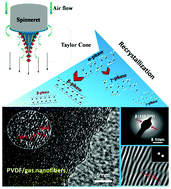Pure OPM nanofibers with high piezoelectricity designed for energy harvesting in vitro and in vivo†
Abstract
Due to inhomogeneous molecular structure and inherent flexibility of organic piezoelectric materials, the improvement in piezoelectric performances is extremely challenging. Herein, a novel sheath-gas-assisted electrospinning method was designed to induce rapid recrystallization and a stretching effect on the PVDF molecular chains, which led to significant promotion in the formation of β and γ crystal phases in PVDF nanofibers and the highest piezoelectric properties reported to date for pure organic piezoelectric materials. By using the PVDF nanofibers for energy harvesting in vivo and in vitro, the motion sensor and implantable nanogenerators displayed excellent sensitivity under an extremely low working frequency of ∼0.1 Hz and considerable output voltage of 0.4–0.6 V cm−2 driven by the femoral artery and carotid artery for the first time. Furthermore, we demonstrated that the nanofibers have outstanding biocompatibility and can provide a spontaneous microelectronic stimulation effect to improve the growth of nerve cells. Thus, we envision that the high-performance piezoelectric nanofibers may serve as a powerful tool for developing future flexible force-sensitive microelectric devices and generators for applications in bioelectronics and biomedicine.



 Please wait while we load your content...
Please wait while we load your content...